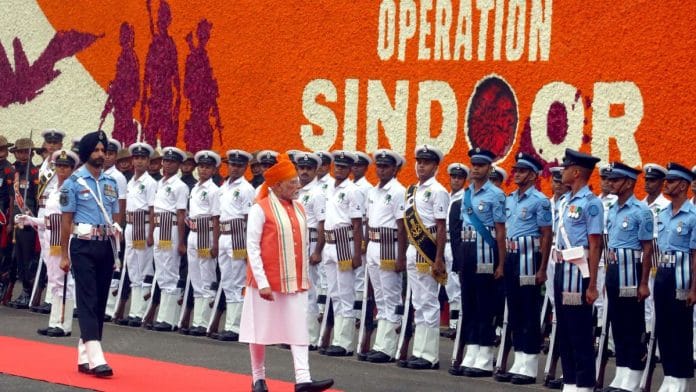New Delhi: Operation Sindoor was centre stage in Prime Minister Narendra Modi’s 79th Independence Day address from the Red Fort on Friday, highlighting India’s swift and decisive response to the 22 April Pahalgam terror attack. Modi’s speech delivered stern warnings to Pakistan, reaffirmed India’s nuclear and defence posture and stressed self-reliance in defence.
Delivering his 12th consecutive Independence Day address, Modi described Operation Sindoor as “a manifestation of the anger that the country was feeling” over the Pahalgam massacre, in which 26 people were killed by terrorists allegedly linked to the Lashkar-e-Taiba (LeT) run The Resistance Front (TRF).
“Entire India was outraged, and the entire world was shocked by such a massacre (Pahalgam). Operation Sindoor was the expression of that outrage…. Destruction in Pakistan is so massive that new revelations are being made every day and new information is coming out daily,” Modi said.
The Prime Minister emphasised that following 22 April, the armed forces were given “a free hand to decide on strategy, objective and timing”. He added, “Our forces did what had never been done for several decades. We entered hundreds of kilometres into enemy soil and razed their terrorist HQ to the ground.”
Last week, Indian Air Force Chief Air Marshal A.P. Singh and Army Chief General Upendra Dwivedi had clarified that no restrictions were imposed by the political leadership on operational aspects of Operation Sindoor, and the armed forces had been free to determine strategy and execution.
Modi also addressed the Indus Waters Treaty, once again asserting that, “Blood and water will not flow together.”
“Rivers from India were irrigating the lands of enemies while my country’s land faced a deficiency of water. For the last seven decades, this agreement harmed the interests of farmers. People now know that the treaty was one-sided and unjust,” he said.
On the broader threat of terrorism, the Prime Minister reiterated what he called a “new normal” in India’s approach, saying that the country will no longer differentiate between terrorists and those who nurture terrorism, describing both as “enemies of humanity.”
He underlined India’s stance against nuclear blackmail, saying, “For a long time, nuclear blackmail has been going on, but this will not be tolerated now. Enemies of the country will be given a befitting reply going forward.”
Modi also highlighted the role of indigenous defence systems during Operation Sindoor. “We have seen the wonders of Made in India in Op Sindoor. Even the enemy was shocked at the kind of ammunition that was destroying them within seconds. Had we not been self-reliant, would we have been able to carry out Operation Sindoor at such a level? In the last 10 years, we set our target to become self-reliant in the defence sector, and today we are seeing the results,” he said.
During Operation Sindoor, the armed forces deployed several homegrown systems, including the Indo-Russian BrahMos cruise missile for precision strikes, BEL’s AkashTeer, the Akash MRSAM for medium-range air defence and the Indo-Israeli Barak-8 for layered aerial protection. On the ground, the indigenous Nagastra-1 loitering munition struck enemy positions with high accuracy, supported by domestic surveillance and targeting systems.
During his address, Modi also called on India’s youth and scientists to focus on developing indigenous capabilities, particularly jet engines for the indigenously developed fighters. He further announced plans to develop an advanced air defence weapon system, named “Sudarshan Chakra”, by 2035 to protect critical national assets.
“In the next ten years, by 2035, I want to expand, strengthen, and modernise this national security shield. Drawing inspiration from Lord Shri Krishna, we have chosen the path of the Sudarshan Chakra…. The nation will be launching the Sudarshan Chakra Mission,” Modi said.
Modi said he felt “immense pride” in saluting the soldiers of Operation Sindoor from the Red Fort and brought to the fore that they had inflicted a level of damage on the enemy that went beyond expectations.
Operation Sindoor’s prominence extended across the Independence Day celebrations. Its logo featured on the view cutter at Gyanpath and in themed floral decorations. Defence personnel awarded gallantry honours on the eve of Independence Day, including nine IAF pilots who were awarded the Vir Chakra for leading the May strike package and destroying terror camps, were present at the Red Fort.
The Indian Air Force also conducted a special flypast, with three helicopters flying in formation carrying the National Flag and the Operation Sindoor flag. Invitations to the event also reflected the operation, featuring its logo on the top right corner and a sketch of the recently inaugurated Chenab railway bridge which connects the Kashmir Valley to the rest of the country by rail for the first time, replacing the Central Vista image previously embossed on the cards.
(Edited by Viny Mishra)
Also read: ‘Goal of Op Sindoor was to enhance PM’s image…military’s hands were tied’—Rahul’s attack on Modi






